Your cart is currently empty!
Tag: My Spanish class
-
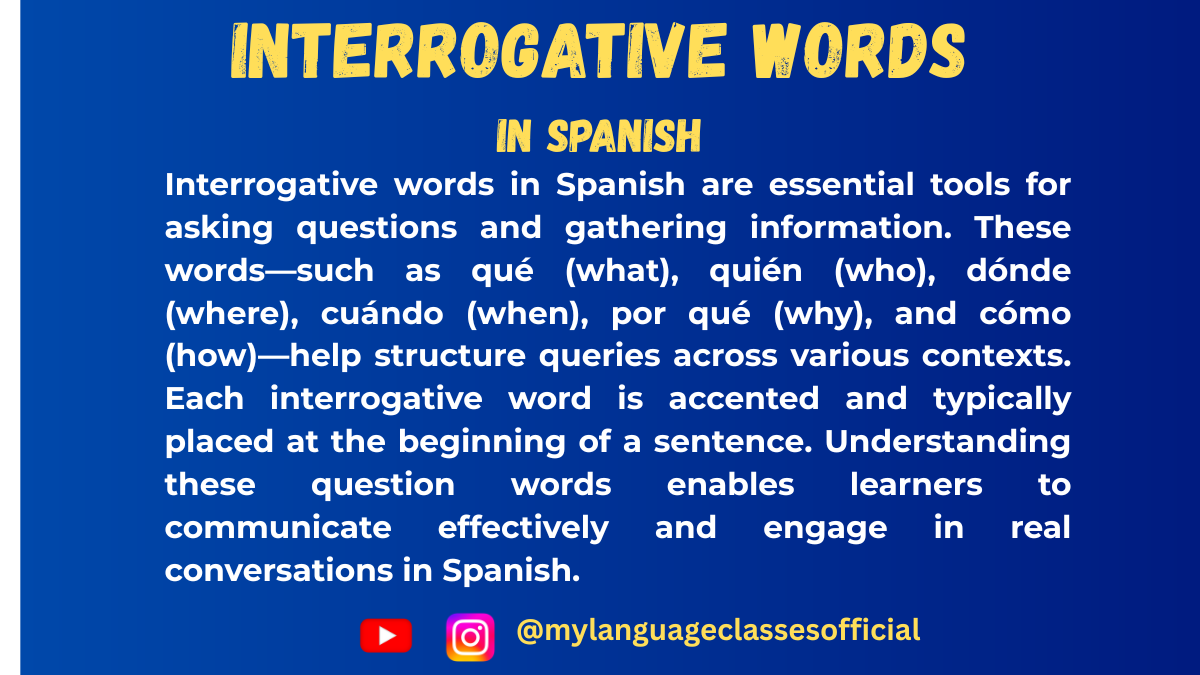
Questions with Interrogative Words in Spanish
Asking questions in Spanish is an essential skill for effective communication. Spanish has various interrogative words that help in forming questions. In this blog, we will cover common interrogative words such as “qué,” “quién,” “cuándo,” “dónde,” “por qué,” “cómo,” “cuánto,” and others. We will also explore their meanings, usage, and structure in different grammatical contexts.
Common Interrogative Words and Their Meanings
Below is a list of the most frequently used interrogative words in Spanish, along with their meanings:
Interrogative Word Meaning Qué What Quién Who Quiénes Who (plural) Cuándo When Dónde Where Por qué Why Cómo How Cuánto How much Cuánta How much (feminine) Cuántos How many (masculine) Cuántas How many (feminine) Cuál Which Cuáles Which (plural) How to Form Questions with Interrogative Words
- Sentence Structure: In Spanish, the interrogative word usually appears at the beginning of the question. The verb generally follows immediately after the interrogative word.
- Example: ¿Dónde está el libro? (Where is the book?)
- Use of Articles:
- In some cases, definite or indefinite articles are needed before the noun.
- Example: ¿Qué es el amor? (What is love?)
- Singular vs. Plural:
- “Cuánto” changes based on gender and number.
- Example: ¿Cuántos libros tienes? (How many books do you have?)
- Example: ¿Cuántas hermanas tienes? (How many sisters do you have?)
- Gender Agreement:
- Some interrogative words change based on gender.
- Example: ¿Cuánto dinero tienes? (How much money do you have?)
- Example: ¿Cuánta agua bebes? (How much water do you drink?)
Beginner and Intermediate Level Interrogative Words with Examples
Interrogative Word Example Sentence 1 Example Sentence 2 Qué ¿Qué quieres comer? (What do you want to eat?) ¿Qué es esto? (What is this?) Quién ¿Quién es él? (Who is he?) ¿Quién viene a la fiesta? (Who is coming to the party?) Cuándo ¿Cuándo es tu cumpleaños? (When is your birthday?) ¿Cuándo llegas? (When are you arriving?) Dónde ¿Dónde vives? (Where do you live?) ¿Dónde está mi mochila? (Where is my backpack?) Por qué ¿Por qué estás triste? (Why are you sad?) ¿Por qué estudias español? (Why do you study Spanish?) Cómo ¿Cómo estás? (How are you?) ¿Cómo funciona esto? (How does this work?) Cuánto ¿Cuánto cuesta? (How much does it cost?) ¿Cuánto tiempo tenemos? (How much time do we have?) More Example Sentences
- ¿Cuáles son tus colores favoritos? (Which are your favorite colors?)
- ¿Cuánta agua bebes al día? (How much water do you drink per day?)
- ¿Dónde compraste ese vestido? (Where did you buy that dress?)
- ¿Por qué no viniste ayer? (Why didn’t you come yesterday?)
- ¿Cómo llegaste aquí? (How did you get here?)
- ¿Qué tipo de música te gusta? (What type of music do you like?)
- ¿Cuándo comienza la película? (When does the movie start?)
- ¿Cuántos amigos tienes? (How many friends do you have?)
- ¿Cuál es tu comida favorita? (Which is your favorite food?)
- ¿Quiénes son esos niños? (Who are those kids?)
Fill in the Blanks
- ¿______ es tu profesor? (Who is your teacher?)
- ¿______ vives? (Where do you live?)
- ¿______ cuesta esta camisa? (How much does this shirt cost?)
- ¿______ vienes a la escuela? (When do you come to school?)
- ¿______ quieres comer? (What do you want to eat?)
- ¿______ estudias español? (Why do you study Spanish?)
- ¿______ hermanos tienes? (How many siblings do you have?)
- ¿______ estás? (How are you?)
- ¿______ son tus zapatos? (Which are your shoes?)
- ¿______ trabaja en esa oficina? (Who works in that office?)
Answers
- Quién 2. Dónde 3. Cuánto 4. Cuándo 5. Qué 6. Por qué 7. Cuántos 8. Cómo 9. Cuáles 10. Quién
Things to Keep in Mind
- Always use an accent (tílde) on interrogative words.
- Adjust the verb conjugation according to the subject.
- Ensure gender and number agreement.
- Some questions require context for clarity.
Conclusion
Mastering interrogative words in Spanish is key to effective communication. Practice these structures and soon, asking and answering questions in Spanish will become second nature!
If you enjoyed this lesson, be sure to check out more posts like this on my blog at My Language Classes. Don’t forget to subscribe my YouTube channel and follow me on Instagram for the latest language learning tips and lessons. Leave a comment below to share your thoughts, or ask any questions you have.
Happy learning! 😊
- Sentence Structure: In Spanish, the interrogative word usually appears at the beginning of the question. The verb generally follows immediately after the interrogative word.
-
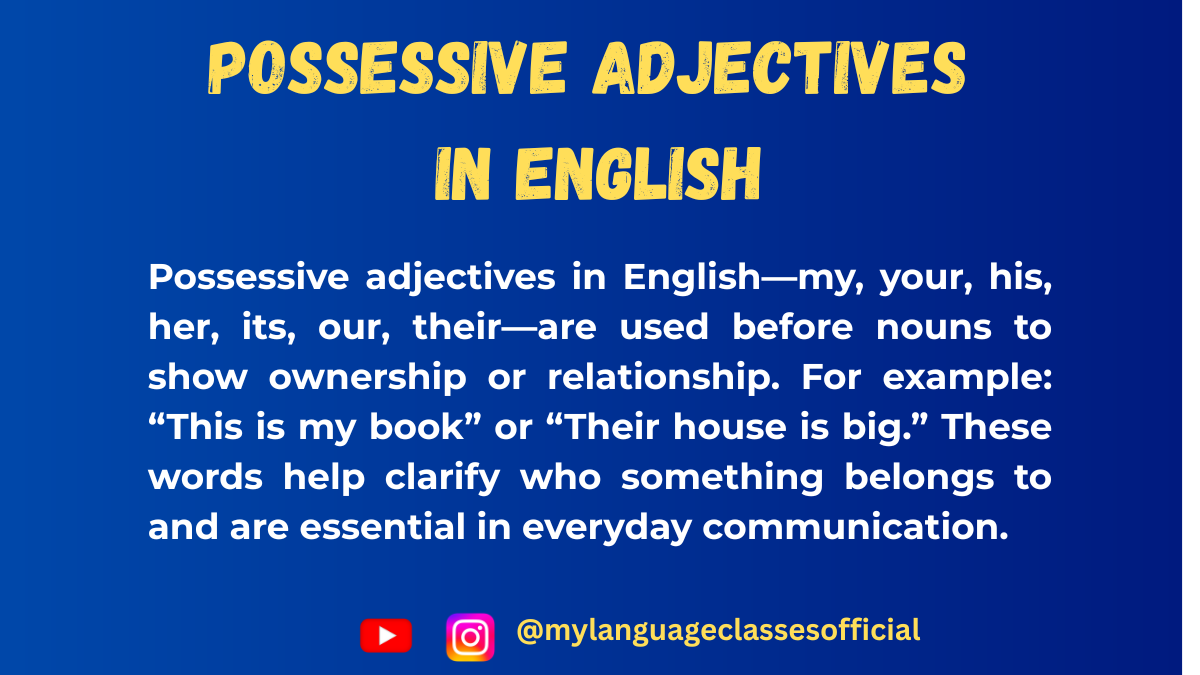
Possessive Adjectives in English
Possessive adjectives are essential in English grammar as they help us indicate ownership or possession. They modify nouns to show who something belongs to and are widely used in everyday communication. In this blog post, we will explore possessive adjectives, their usage, examples, and exercises to help you master them.
What Are Possessive Adjectives?
Possessive adjectives are words that show ownership or belonging. They always come before a noun and modify it to indicate possession. The most common possessive adjectives in English are:
- my
- your
- his
- her
- its
- our
- their
These adjectives replace the need for a noun to show possession explicitly.
Usage of Possessive Adjectives
Possessive adjectives are used in various situations:
- Indicating Ownership – Used to show that something belongs to someone.
Example: This is my book. - Talking About Relationships – Used to describe family members, friends, or connections.
Example: His brother is a doctor. - Describing Body Parts – Used instead of definite articles (e.g., the).
Example: She injured her leg. - Referring to Pets and Objects – Used to show ownership of pets or things.
Example: The dog is wagging its tail. - Indicating Group Ownership – Used for plural subjects.
Example: This is our house. - Addressing Someone Formally and Informally – “Your” can be used in both formal and informal contexts.
Example: Your car is parked outside. - Expressing Feelings or Thoughts – Used to describe personal emotions, beliefs, or opinions.
Example: My opinion is different from yours. - Talking About Time and Events – Used when referring to specific times or occasions.
Example: We enjoyed our holiday. - Indicating Professional Roles or Responsibilities – Used for job positions or tasks.
Example: Her manager is very supportive. - Possession in Abstract Concepts – Used for things like names, ideas, or dreams.
Example: His idea was brilliant.
List of Possessive Adjectives with Example Sentences
Possessive Adjective Beginner Level Example Intermediate Level Example My This is my pen. My thoughts are clear now. Your Is this your book? I respect your decision. His His bike is red. I don’t understand his logic. Her Her dress is beautiful. Her dedication to work is impressive. Its The dog wagged its tail. The company changed its policy. Our Our school is big. We must protect our environment. Their Their house is near the park. Their success is well-deserved. More Example Sentences
- She forgot her keys at home.
- This is my favorite song.
- I love your cooking.
- He took his jacket and left.
- The cat licked its paws.
- We had a great time at our wedding.
- They visited their grandparents last summer.
- Please submit your assignments on time.
- He is proud of his achievements.
- The dog followed its owner.
Fill in the Blanks
- Is this ___ book? (your/my)
- He forgot ___ phone at home. (his/its)
- We love spending time with ___ family. (our/their)
- She borrowed ___ pen to write a note. (his/her)
- The cat licked ___ fur after the bath. (its/her)
- They celebrated ___ anniversary last night. (their/our)
- I don’t understand ___ reasoning. (his/your)
- We went to ___ favorite restaurant. (my/our)
- The teacher praised ___ students. (her/his)
- You should respect ___ elders. (their/your)
Answers
- your
- his
- our
- her
- its
- their
- his
- our
- her
- your
Things to Keep in Mind
- Possessive adjectives must be followed by a noun. (e.g., My car is new. NOT My is new.)
- “Its” is not the same as “it’s.” (“Its” shows possession, while “it’s” is a contraction of “it is.”)
- Possessive adjectives do not change based on gender except “his” and “her.”
- Unlike possessive pronouns, possessive adjectives always require a noun. (e.g., This is my book. vs. This book is mine.)
- Possessive adjectives agree with the possessor, not the thing possessed. (e.g., His sister (not Her sister) when referring to a boy’s sister.)
Conclusion
Possessive adjectives play a crucial role in English grammar by indicating ownership and relationships. They are commonly used in everyday communication and are easy to learn with practice. By understanding their usage and applying them in sentences, you can improve your English fluency significantly. Keep practicing with the examples and exercises provided, and soon, possessive adjectives will become second nature to you!
If you enjoyed this lesson, be sure to check out more posts like this on my blog at My Language Classes. Don’t forget to subscribe my YouTube channel and follow me on Instagram for the latest language learning tips and lessons. Leave a comment below to share your thoughts, or ask any questions you have about nouns.
Happy learning! 😊
-
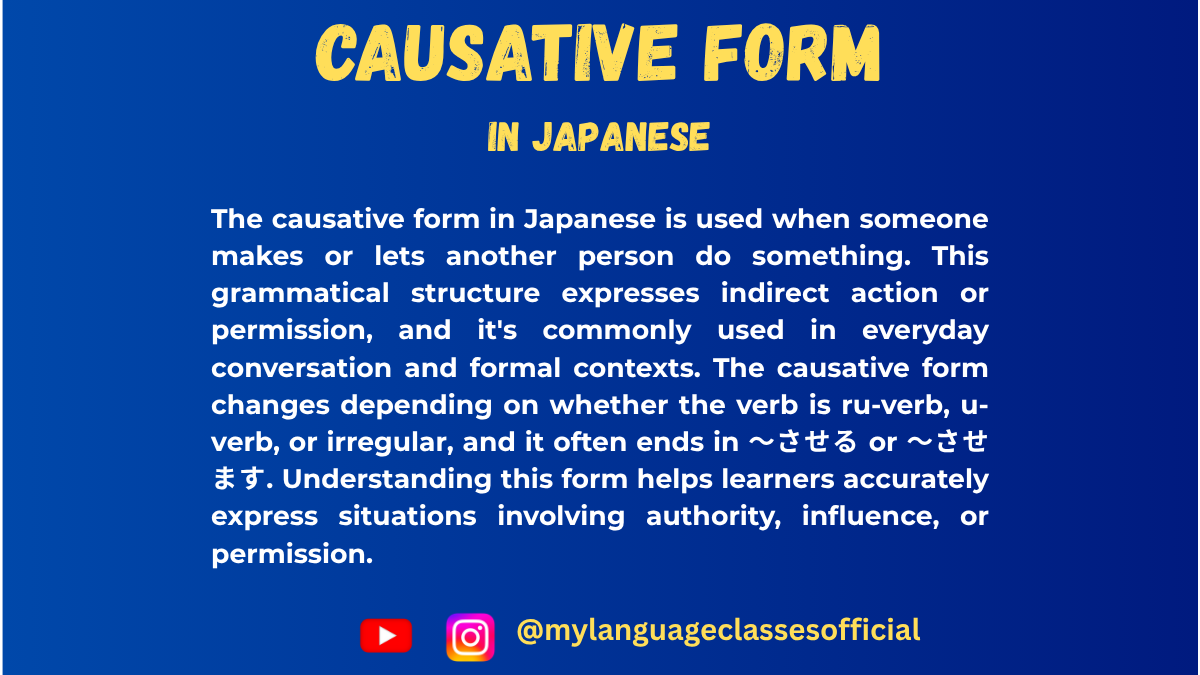
Causative Form of Verbs in Japanese | My Language Classes
Understanding Causative Form in Japanese
The causative form in Japanese is used to express situations where someone makes or allows another person to do something. This grammatical structure is essential for both beginners and intermediate learners as it plays a vital role in daily conversations and formal settings.
Formation of the Causative Form
The causative form in Japanese follows a specific conjugation pattern based on the verb group.
Group 1 (Ichidan Verbs – る-verbs)
- Drop る and add させる
- Example: 食べる → 食べさせる (taberu → tabesaseru) – “to make/let someone eat”
Group 2 (Godan Verbs – う-verbs)
- Change the final う sound to あ and add せる
- Example: 書く → 書かせる (kaku → kakaseru) – “to make/let someone write”
Irregular Verbs
- する → させる
- くる → こさせる
Usage of Causative Form
1. Making Someone Do Something
When the subject forces someone to do something.
- 先生は生徒に本を読ませた。
- Sensei wa seito ni hon o yomaseta.
- “The teacher made the student read the book.”
2. Allowing Someone to Do Something
When the subject permits another person to do something.
- 母は子供にアイスクリームを食べさせた。
- Haha wa kodomo ni aisukurīmu o tabesaseta.
- “The mother let the child eat ice cream.”
3. When Used with Intransitive Verbs
It means “to let someone” do something.
- 友達は私を早く帰らせた。
- Tomodachi wa watashi o hayaku kaeraseta.
- “My friend let me go home early.”
4. Causative-Passive Form (When Someone Is Made to Do Something Unwillingly)
- 先生に宿題をたくさんやらせられた。
- Sensei ni shukudai o takusan yaraserareta.
- “I was made to do a lot of homework by the teacher.”
Situations Where Causative Form Is Used
- Forcing someone to do something
- Giving permission to do something
- Describing workplace instructions
- Formal requests in a business setting
- Parenting and teaching situations
- Expressing feelings of obligation
- Telling someone to act on your behalf
Beginner and Intermediate Level Verbs with Causative Form and Example Sentences
Verb (Dictionary Form) Causative Form Example Sentence 1 Romaji English Example Sentence 2 Romaji English 食べる (taberu) 食べさせる (tabesaseru) 母は私に野菜を食べさせた。 Haha wa watashi ni yasai o tabesaseta. “My mother made me eat vegetables.” 先生は生徒に昼ご飯を食べさせた。 Sensei wa seito ni hirugohan o tabesaseta. “The teacher let the students eat lunch.” 行く (iku) 行かせる (ikaseru) 父は私を学校に行かせた。 Chichi wa watashi o gakkō ni ikaseta. “My father made me go to school.” 先生は生徒を旅行に行かせた。 Sensei wa seito o ryokō ni ikaseta. “The teacher let the students go on a trip.” 書く (kaku) 書かせる (kakaseru) 先生は生徒に作文を書かせた。 Sensei wa seito ni sakubun o kakaseta. “The teacher made the student write an essay.” 彼は弟に手紙を書かせた。 Kare wa otōto ni tegami o kakaseta. “He made his younger brother write a letter.”
More Example Sentences
- 先生は生徒に宿題をやらせた。
- 友達は私にその映画を見させた。
- 母は私に皿を洗わせた。
- 父は私にピアノを弾かせた。
- 会社は社員に報告書を書かせた。
- 医者は患者に薬を飲ませた。
- 先生は学生を立たせた。
- 兄は弟に犬を散歩させた。
- 友達は私に試験の問題を解かせた。
- 父は私に手伝いをさせた。
Fill in the Blanks
- 先生は生徒に本を ___ 。
- 母は子供に野菜を ___ 。
- 友達は私を早く ___ 。
- 父は私に宿題を ___ 。
- 医者は患者に薬を ___ 。
- 先生は生徒に黒板に字を ___ 。
- 社長は部下にレポートを ___ 。
- 兄は弟にピアノを ___ 。
- 友達は私に試験の答えを ___ 。
- 先生は学生を立たせた。
Answers
- 読ませた
- 食べさせた
- 帰らせた
- やらせた
- 飲ませた
- 書かせた
- 書かせた
- 弾かせた
- 解かせた
- 立たせた
Things to Keep in Mind
- The causative form can indicate both “making someone do” and “letting someone do” an action.
- The causative-passive form (e.g., やらせられる) is often used when someone is forced to do something against their will.
- The particle に is used to indicate the person being caused to act.
- Some sentences may sound unnatural if used without context, so always consider the situation.
Conclusion
The causative form in Japanese is essential for expressing permission, coercion, and obligation. Mastering it will help you create more nuanced sentences in conversations and formal settings. Keep practicing with different verbs and contexts, and soon, using the causative form will become second nature!
If you enjoyed this lesson, be sure to check out more posts like this on my blog at My Language Classes. Don’t forget to subscribe my YouTube channel and follow me on Instagram for the latest language learning tips and lessons. Leave a comment below to share your thoughts, or ask any questions you have about nouns.
Happy learning! 😊
- Drop る and add させる
-
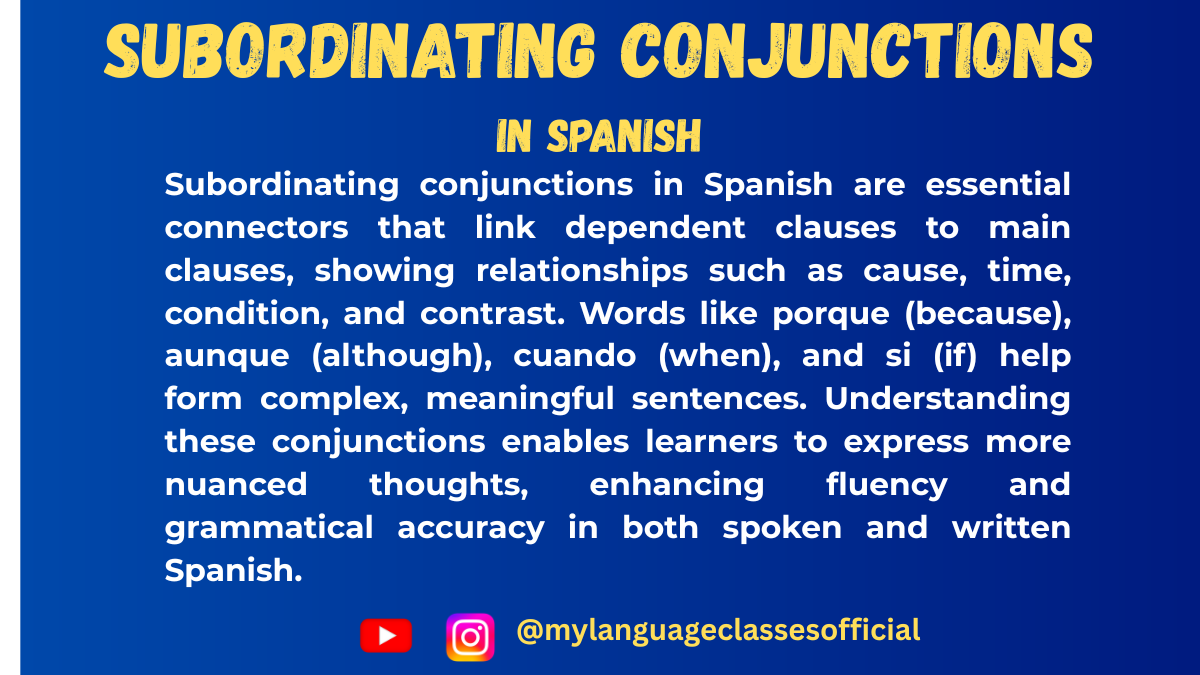
Subordinating Conjunctions in Spanish: porque, que, cuando, aunque, and Others
Subordinating conjunctions in Spanish are essential for connecting clauses, providing reasons, expressing conditions, and indicating time. These conjunctions introduce subordinate clauses, which depend on the main clause to complete their meaning. Understanding their usage will significantly improve your fluency in Spanish.
List of Common Subordinating Conjunctions and Their Uses
Below is a list of the most commonly used subordinating conjunctions in Spanish along with their meanings and examples:
Conjunction Meaning Example 1 Example 2 porque because No salí porque llovía. (I didn’t go out because it was raining.) Estudio mucho porque quiero aprobar. (I study a lot because I want to pass.) que that Me dijo que vendría. (He told me that he would come.) Creo que es una buena idea. (I think that it is a good idea.) cuando when Te llamaré cuando llegue. (I will call you when I arrive.) Cuando era niño, jugaba mucho. (When I was a child, I played a lot.) aunque although/even though Aunque está lloviendo, saldré. (Even though it is raining, I will go out.) Lo haré aunque no tenga ganas. (I will do it even if I don’t feel like it.) si if Si estudias, aprobarás. (If you study, you will pass.) Iré si tengo tiempo. (I will go if I have time.) como as/since Lo hice como me dijiste. (I did it as you told me.) Como hace frío, me pondré un abrigo. (Since it is cold, I will wear a coat.) porque because No fui porque estaba enfermo. (I didn’t go because I was sick.) Lo hicimos porque era necesario. (We did it because it was necessary.) mientras while/as long as Puedes quedarte mientras quieras. (You can stay as long as you want.) Mientras yo cocino, tú pones la mesa. (While I cook, you set the table.) para que so that Te lo explico para que lo entiendas. (I explain it to you so that you understand.) Trabajo duro para que mis hijos tengan una mejor vida. (I work hard so that my children have a better life.) hasta que until No saldrás hasta que termines la tarea. (You will not go out until you finish your homework.) Esperaré hasta que llegues. (I will wait until you arrive.)
More Example Sentences
- No me gusta que llegues tarde. (I don’t like that you arrive late.)
- Como no tenía dinero, no compré nada. (Since I had no money, I didn’t buy anything.)
- Siempre me llama cuando necesita ayuda. (He always calls me when he needs help.)
- Aunque hace frío, no llevo abrigo. (Although it is cold, I am not wearing a coat.)
- Si tienes hambre, come algo. (If you are hungry, eat something.)
- Se quedó hasta que terminó la película. (He stayed until the movie ended.)
- Te hablo despacio para que me entiendas. (I speak slowly so that you understand me.)
- Mientras yo limpio, tú organizas la mesa. (While I clean, you organize the table.)
- Me gusta que me ayudes. (I like that you help me.)
- No salgas hasta que te llame. (Do not go out until I call you.)
Fill in the Blanks
- No saldré ______ termine mi tarea.
- Te lo explico ______ lo entiendas.
- ______ estudies, no aprenderás.
- Me dijo ______ vendría.
- Saldré ______ haga calor o frío.
- Esperaré ______ llegues.
- ______ no vengas temprano, perderemos el tren.
- No me gusta ______ me hables así.
- Comeré ______ tenga hambre.
- Salimos temprano ______ no había tráfico.
Answers
- hasta que
- para que
- Si no
- que
- aunque
- hasta que
- Si
- que
- cuando
- porque
Things to Keep in Mind
- Word Order: In Spanish, subordinating conjunctions typically introduce the subordinate clause, which follows the main clause.
- Verb Tense: Some conjunctions require the use of the subjunctive mood, especially when expressing uncertainty, purpose, or conditions (e.g., “para que” requires the subjunctive: “para que me entiendas”).
- Gender and Plurality: Conjunctions themselves do not change based on gender or plurality, but the words around them do. Make sure the verbs and adjectives agree with the subject.
- Use of Articles: Articles (el, la, los, las) do not affect subordinating conjunctions, but they must agree with the nouns they accompany.
- Common Mistakes: Beginners often confuse “porque” (because) with “por que” (for which) and “por qué” (why). Understanding their differences is crucial.
Conclusion
Mastering subordinating conjunctions in Spanish is essential for fluency, as they help create complex and meaningful sentences. Whether expressing reasons, conditions, or time, these conjunctions enhance communication and improve sentence structure. By practicing with real-life examples and exercises, you can become more confident in using them correctly. Keep practicing and incorporating these into daily conversations to strengthen your command of Spanish!
If you enjoyed this lesson, be sure to check out more posts like this on my blog at My Language Classes. Don’t forget to subscribe my YouTube channel and follow me on Instagram for the latest language learning tips and lessons. Leave a comment below to share your thoughts, or ask any questions you have.
Happy learning! 😊
-
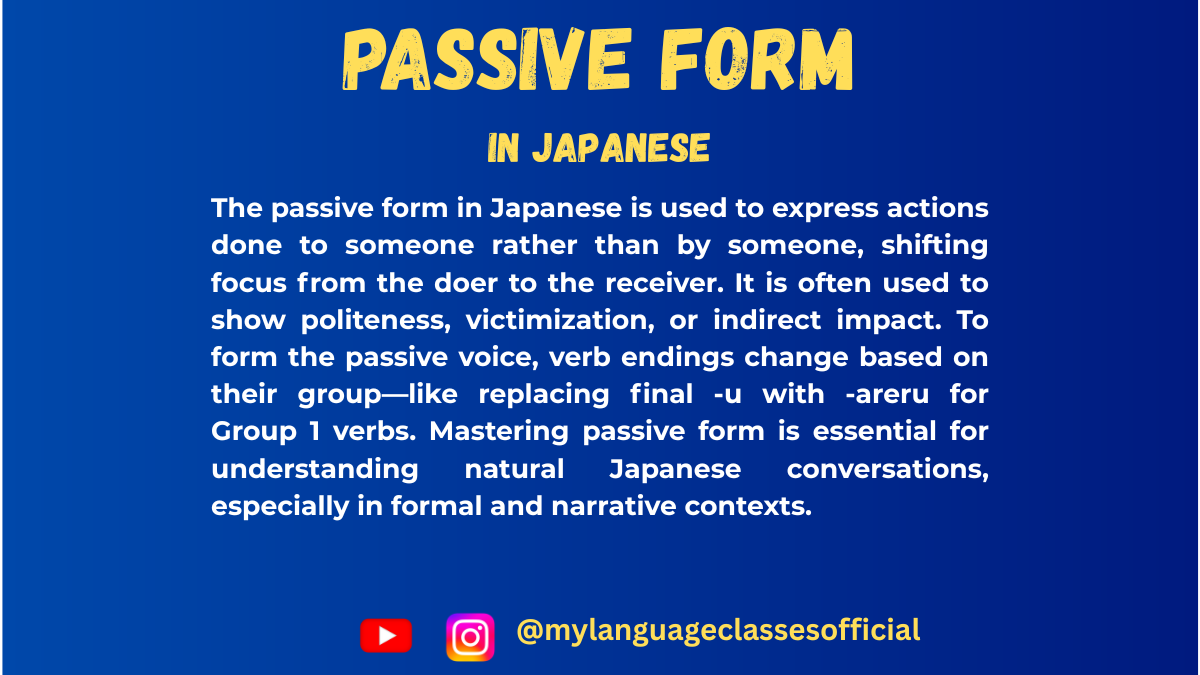
Passive Form of Verbs in Japanese | My Language Classes
Understanding Passive Form in Japanese
The passive form (受身形, うけみけい) in Japanese is used in various situations, primarily to describe actions where the subject is affected by someone else’s actions. Unlike in English, where the passive voice is often avoided, Japanese frequently uses it in daily conversations and formal writing. In this blog post, we will thoroughly explore the formation and usage of passive verbs in different contexts.
Usage of Passive Form in Japanese
The passive form is used in the following situations:
- When someone is negatively affected by an action (被害受身 – ひがいうけみ)
- Japanese: 私は弟にケーキを食べられました。
- Romaji: Watashi wa otōto ni kēki o taberaremashita.
- Meaning: I had my cake eaten by my younger brother.
- When describing an event from the perspective of the affected person
- Japanese: 私は先生にほめられました。
- Romaji: Watashi wa sensei ni homeraremashita.
- Meaning: I was praised by my teacher.
- When discussing historical or public events
- Japanese: このお寺は100年前に建てられました。
- Romaji: Kono otera wa hyaku nen mae ni tateraremashita.
- Meaning: This temple was built 100 years ago.
- When avoiding mentioning the doer explicitly (formal, impersonal expressions)
- Japanese: 日本ではお米が多く食べられています。
- Romaji: Nihon de wa okome ga ōku taberareteimasu.
- Meaning: Rice is widely eaten in Japan.
- When talking about natural phenomena
- Japanese: その山は雪で覆われています。
- Romaji: Sono yama wa yuki de ōwareteimasu.
- Meaning: That mountain is covered with snow.
- In literary or poetic expressions
- Japanese: 彼女の歌は世界中で聞かれています。
- Romaji: Kanojo no uta wa sekaijū de kikareteimasu.
- Meaning: Her songs are heard all over the world.
Formation of Passive Verbs
Japanese verbs are categorized into three groups. The passive form is formed differently for each group.
Group 1 (Ichidan verbs / 一段動詞)
Formation: Drop the final る and add られる
Verb Potential Form Passive Form Example Sentence (Japanese) Romaji Meaning 食べる (たべる) 食べられる 食べられる 私は友達にお菓子を食べられた。 Watashi wa tomodachi ni okashi o taberareta. I had my sweets eaten by a friend. 見る (みる) 見られる 見られる 私の秘密はみんなに見られた。 Watashi no himitsu wa minna ni mirareta. My secret was seen by everyone. 教える (おしえる) 教えられる 教えられる 日本語は先生に教えられた。 Nihongo wa sensei ni oshierareta. Japanese was taught by the teacher. Group 2 (Godan verbs / 五段動詞)
Formation: Change the final u sound to a sound and add れる
Verb Potential Form Passive Form Example Sentence (Japanese) Romaji Meaning 書く (かく) 書ける 書かれる 私の名前が黒板に書かれた。 Watashi no namae ga kokuban ni kakareta. My name was written on the blackboard. 読む (よむ) 読める 読まれる この本は多くの人に読まれた。 Kono hon wa ōku no hito ni yomareta. This book was read by many people. 言う (いう) 言える 言われる 先生に「すごい」と言われた。 Sensei ni “sugoi” to iwareta. I was told “amazing” by the teacher. Group 3 (Irregular verbs / 不規則動詞)
Verb Potential Form Passive Form Example Sentence (Japanese) Romaji Meaning する できる される 彼の仕事は上司に評価された。 Kare no shigoto wa jōshi ni hyōka sareta. His work was evaluated by the boss. 来る (くる) 来られる 来られる 私の家に友達が来られた。 Watashi no ie ni tomodachi ga korareta. A friend came to my house.
More Example Sentences
- 彼は友達にからかわれた。 (Kare wa tomodachi ni karakawareta.) – He was teased by his friends.
- 雨が降って、試合が中止された。 (Ame ga futte, shiai ga chūshi sareta.) – The match was canceled due to rain.
- 私の自転車が盗まれた。 (Watashi no jitensha ga nusumareta.) – My bicycle was stolen.
- その映画は世界中で見られている。 (Sono eiga wa sekaijū de mirareteiru.) – The movie is being watched worldwide.
- 彼は先生に叱られた。 (Kare wa sensei ni shikarareta.) – He was scolded by the teacher.
- この本は多くの人に読まれた。 (Kono hon wa ōku no hito ni yomareta.) – This book was read by many people.
- 先生に質問が聞かれた。 (Sensei ni shitsumon ga kikareta.) – A question was asked by the teacher.
- 日本では魚がよく食べられる。 (Nihon de wa sakana ga yoku taberareru.) – Fish is often eaten in Japan.
- その話は新聞に書かれていた。 (Sono hanashi wa shinbun ni kakareteita.) – That story was written in the newspaper.
- 彼の名前は歴史に残されている。 (Kare no namae wa rekishi ni nokosareteiru.) – His name is left in history.
Fill in the Blanks Exercise:
- 私の名前が黒板に____。
- 先生にほめ____。
- 私は友達にお弁当を____。
- その建物は100年前に____。
- その映画はたくさんの人に____。
- 宿題が____。
- 彼は友達に____。
- その話は新聞に____。
- 日本では魚がよく____。
- 彼の仕事は上司に____。
Answers:
- 書かれた 2. られた 3. 食べられた 4. 建てられた 5. 見られた 6. された 7. からかわれた 8. 書かれた 9. 食べられる 10. 評価された
Things to Keep in Mind
- Passive verbs often imply an indirect effect on the subject.
- Passive form is commonly used in formal writing and polite speech.
- Certain verbs are more frequently used in passive form, such as 言う (to say), 書く (to write), and する (to do).
- When the subject is negatively affected, the nuance of 被害受身 (negative passive) comes into play.
- Passive sentences often omit the doer (agent) for a softer, indirect tone.
Conclusion
Mastering the passive form of verbs in Japanese is crucial for fluency and understanding natural speech patterns. It is widely used in both formal and informal contexts. By practicing passive verb conjugations and understanding their nuanced usage, learners can improve their comprehension and communication skills in Japanese effectively. Keep practicing and using these forms in daily conversation to become more proficient!
If you enjoyed this lesson, be sure to check out more posts like this on my blog at My Language Classes. Don’t forget to subscribe my YouTube channel and follow me on Instagram for the latest language learning tips and lessons. Leave a comment below to share your thoughts, or ask any questions you have about nouns.
Happy learning! 😊
- When someone is negatively affected by an action (被害受身 – ひがいうけみ)
-

Coordinating Conjunctions in Spanish: y, o, pero, sino, and Others
Coordinating conjunctions (conjunciones coordinantes) in Spanish are essential for connecting words, phrases, and clauses that are grammatically equal. They help create fluid and coherent speech and writing. This article will explain the main coordinating conjunctions in Spanish, their uses, and common expressions that feature them in everyday conversation.
Types of Coordinating Conjunctions
Spanish coordinating conjunctions are categorized into four main types:
- Copulative Conjunctions (Conjunciones Copulativas) – Used to add information.
- Disjunctive Conjunctions (Conjunciones Disyuntivas) – Used to offer alternatives.
- Adversative Conjunctions (Conjunciones Adversativas) – Used to express contrast.
- Distributive Conjunctions (Conjunciones Distributivas) – Used to indicate alternation or distribution.
List of Common Coordinating Conjunctions with Examples
Conjunction Type Meaning Example Sentences y Copulative and Me gusta el café y el té. (I like coffee and tea.) e Copulative and (used before words starting with ‘i’ or ‘hi’) Estudia inglés e italiano. (He studies English and Italian.) ni Copulative neither/nor No quiero comer ni beber. (I don’t want to eat or drink.) o Disjunctive or ¿Quieres café o té? (Do you want coffee or tea?) u Disjunctive or (used before words starting with ‘o’ or ‘ho’) Prefieres ocho u once manzanas? (Do you prefer eight or eleven apples?) pero Adversative but Quiero ir, pero no tengo tiempo. (I want to go, but I don’t have time.) sino Adversative but rather No quiero café, sino té. (I don’t want coffee, but rather tea.) mas Adversative but (formal) Tengo dinero, mas no lo gastaré. (I have money, but I will not spend it.) bien… bien… Distributive either… or… Bien estudias, bien trabajas. (Either you study or you work.) ya… ya… Distributive sometimes… sometimes… Ya canta, ya baila. (Sometimes he sings, sometimes he dances.)
Detailed Explanation of Key Coordinating Conjunctions
1. Copulative Conjunctions: y, e, ni
- Used to add elements in a sentence.
- ‘e’ is used instead of ‘y’ when the next word starts with ‘i’ or ‘hi’ to avoid phonetic confusion.
- ‘ni’ is used in negative sentences to mean “neither… nor.”
✅ Examples:
- Compré pan y leche. (I bought bread and milk.)
- Estudia francés e italiano. (He studies French and Italian.)
- No tengo hambre ni sed. (I am neither hungry nor thirsty.)
- No quiero ver televisión ni escuchar música. (I don’t want to watch TV nor listen to music.)
2. Disjunctive Conjunctions: o, u
- Used to offer choices or alternatives.
- ‘u’ replaces ‘o’ when the next word starts with ‘o’ or ‘ho’.
✅ Examples:
- ¿Quieres jugo o agua? (Do you want juice or water?)
- Prefieres ocho u once años. (Do you prefer eight or eleven years?)
- ¿Tomamos el autobús o caminamos? (Shall we take the bus or walk?)
3. Adversative Conjunctions: pero, sino, mas
- Used to contrast ideas.
- ‘Sino’ is used after a negative phrase to mean “but rather.”
- ‘Mas’ is a formal way to say “but” (used in literary contexts).
✅ Examples:
- Me gusta la pizza, pero prefiero la pasta. (I like pizza, but I prefer pasta.)
- No compré el vestido, sino los zapatos. (I didn’t buy the dress, but rather the shoes.)
- Quería ir, mas no tenía coche. (I wanted to go, but I didn’t have a car.)
- No es rojo, sino azul. (It’s not red, but rather blue.)
More Example Sentences:
1.María y Juan fueron al cine anoche. (María and Juan went to the movies last night.) – Copulative (y)
2.Pedro e Isabel son hermanos. (Pedro and Isabel are siblings.) – Copulative (e, used before ‘i’ sound)
3.No me gusta el fútbol ni el baloncesto. (I don’t like soccer nor basketball.) – Copulative (ni)
4.¿Quieres leer un libro o ver una película? (Do you want to read a book or watch a movie?) – Disjunctive (o)
5.Necesitamos siete u ocho sillas para la fiesta. (We need seven or eight chairs for the party.) – Disjunctive (u, used before ‘o’ sound)
6.Estaba cansado, pero siguió trabajando. (He was tired, but he kept working.) – Adversative (pero)
7.No compré la manzana, sino la pera. (I didn’t buy the apple, but rather the pear.) – Adversative (sino, after a negative clause)
8.Quería llamarte, mas no tenía batería en el teléfono. (I wanted to call you, but I had no battery on my phone.) – Adversative (mas, formal use of ‘but’)
9.Bien cocina, bien limpia la casa. (Either he cooks, or he cleans the house.) – Distributive (bien… bien…)
10.Ya duerme, ya mira televisión. (Sometimes she sleeps, sometimes she watches TV.) – Distributive (ya… ya…)
These sentences showcase various coordinating conjunctions in different contexts. Let me know in comment if you need more!
Fill in the Blanks Questions:
- Me gustan los perros __ los gatos. (and)
- No quiero sopa __ ensalada. (but rather)
- ¿Quieres agua __ jugo? (or)
- No tengo hambre __ sed. (nor)
- No solo canta, __ también baila. (but also)
- Puedes comer pollo __ pescado. (or)
- No compré un coche, __ una bicicleta. (but rather)
- Salimos temprano, __ llegamos tarde. (but)
- No es un problema fácil, __ difícil. (but rather)
- __ llueve, __ hace sol. (Sometimes… sometimes…)
Answers
- y
- sino
- o
- ni
- sino
- o
- sino
- pero
- sino
- Ya… ya…
Conclusion
Mastering coordinating conjunctions will help you improve sentence flow, coherence, and clarity in Spanish. Keep practicing these expressions in daily conversations!
If you enjoyed this lesson, be sure to check out more posts like this on my blog at My Language Classes. Don’t forget to subscribe my YouTube channel and follow me on Instagram for the latest language learning tips and lessons. Leave a comment below to share your thoughts, or ask any questions you have.
Happy learning! 😊
-
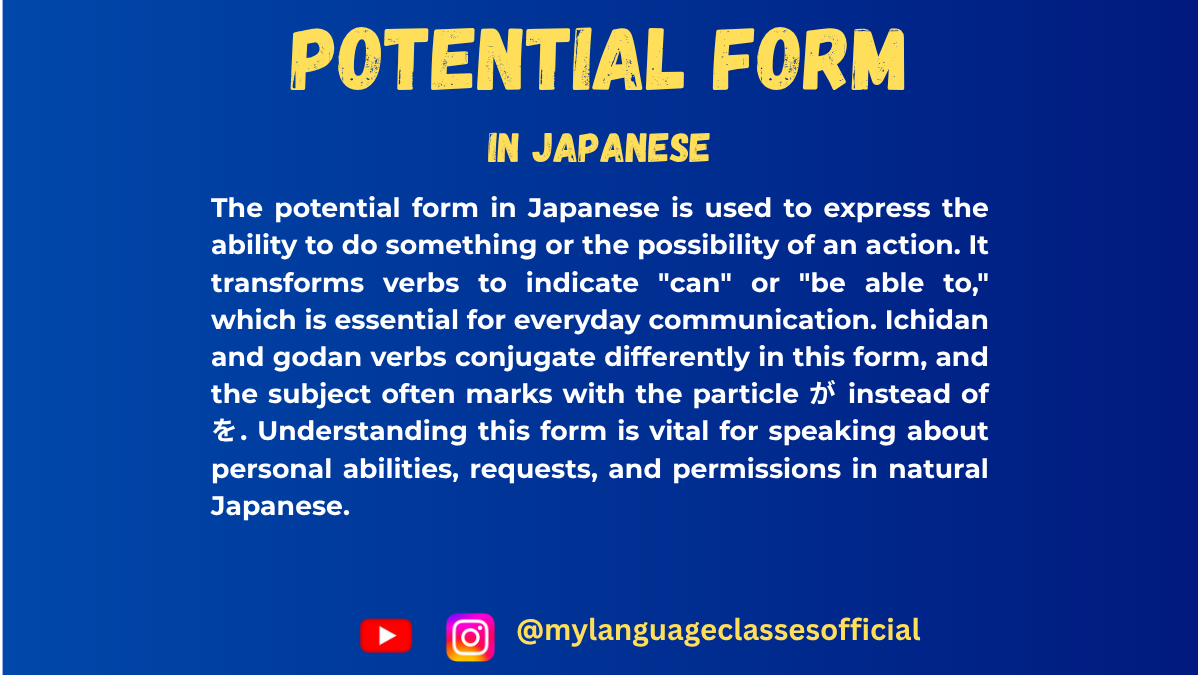
Potential Form of Verbs in Japanese | My Language Classes
Understanding Potential Form
The potential form (可能形, かのうけい) of verbs in Japanese expresses the ability or possibility to do something. This form is widely used in everyday conversations to talk about what someone can or cannot do.
Usage of Potential Form in Different Situations
- Expressing Ability
- 日本語を話せます。(I can speak Japanese.)
- Expressing Capability
- ここから富士山が見えます。(You can see Mount Fuji from here.)
- Expressing Permission
- この図書館では本を借りられます。(You can borrow books in this library.)
- Expressing Physical or Situational Possibility
- 今日は忙しいので、映画に行けません。(I am busy today, so I can’t go to the movies.)
- Expressing Potential in Hypothetical Scenarios
- 彼が来たら、もっと話せると思います。(If he comes, I think I will be able to talk more.)
- Asking About Ability
- ピアノが弾けますか? (Can you play the piano?)
- Denying Capability
- 漢字が読めません。(I can’t read kanji.)
- Expressing Limited Ability (Using なら)
- スペイン語なら話せます。(If it’s Spanish, I can speak it.)
Formation of Potential Form
Japanese verbs are categorized into three groups, and the potential form is formed differently for each.
Group 1 (Godan Verbs / 五段動詞)
For 五段動詞 (Godan verbs), replace the final う sound with える.
Dictionary Form Potential Form Example Sentence 1 Example Sentence 2 書く (to write) 書ける 日本語が書けます。(I can write in Japanese.) 漢字が書けません。(I can’t write kanji.) 行く (to go) 行ける 明日、海に行けます。(I can go to the beach tomorrow.) 東京には行けません。(I can’t go to Tokyo.) 話す (to speak) 話せる 日本語が話せますか?(Can you speak Japanese?) 彼は英語が話せません。(He can’t speak English.) 飲む (to drink) 飲める お酒が飲めますか?(Can you drink alcohol?) ビールが飲めません。(I can’t drink beer.) 泳ぐ (to swim) 泳げる 彼は速く泳げます。(He can swim fast.) 海では泳げません。(I can’t swim in the sea.) 買う (to buy) 買える この店でケーキが買えます。(You can buy cakes at this shop.) 今日は買えません。(I can’t buy it today.) 作る (to make) 作れる 美味しい料理が作れます。(I can make delicious food.) パンは作れません。(I can’t make bread.) Group 2 (Ichidan Verbs / 一段動詞)
For 一段動詞 (Ichidan verbs), replace る with られる.
Dictionary Form Potential Form Example Sentence 1 Example Sentence 2 食べる (to eat) 食べられる 何でも食べられます。(I can eat anything.) 魚が食べられません。(I can’t eat fish.) 見る (to see) 見られる この映画が見られます。(You can watch this movie.) 明日は見られません。(I can’t watch it tomorrow.) 着る (to wear) 着られる 和服が着られます。(I can wear a kimono.) その服は着られません。(I can’t wear those clothes.) 起きる (to wake up) 起きられる 朝6時に起きられます。(I can wake up at 6 AM.) 今日は早く起きられません。(I can’t wake up early today.) 忘れる (to forget) 忘れられる 昨日のことが忘れられます。(I can forget about yesterday.) その話は忘れられません。(I can’t forget that story.) Group 3 (Irregular Verbs / 不規則動詞)
The two irregular verbs in Japanese have unique potential forms.
Dictionary Form Potential Form Example Sentence 1 Example Sentence 2 する (to do) できる サッカーができます。(I can play soccer.) 今日は運動ができません。(I can’t exercise today.) 来る (to come) 来られる 彼は会議に来られます。(He can come to the meeting.) 明日は来られません。(I can’t come tomorrow.) More Example Sentences
- 私は日本語が話せます。
(I can speak Japanese.) → [Godan Verb: 話す → 話せる] - この店ではケーキが買えます。
(You can buy cakes at this shop.) → [Godan Verb: 買う → 買える] - 今日は早く起きられません。
(I can’t wake up early today.) → [Ichidan Verb: 起きる → 起きられる] - この映画はネットで見られます。
(You can watch this movie online.) → [Ichidan Verb: 見る → 見られる] - ピアノが弾けますか?
(Can you play the piano?) → [Godan Verb: 弾く → 弾ける] - 彼は速く泳げます。
(He can swim fast.) → [Godan Verb: 泳ぐ → 泳げる] - 明日は学校に行けません。
(I can’t go to school tomorrow.) → [Godan Verb: 行く → 行ける] - この本は図書館で借りられます。
(You can borrow this book from the library.) → [Ichidan Verb: 借りる → 借りられる] - サッカーができますか?
(Can you play soccer?) → [Irregular Verb: する → できる] - 彼は明日の会議に来られます。
(He can come to tomorrow’s meeting.) → [Irregular Verb: 来る → 来られる]
These examples cover various real-life situations where the potential form is commonly used. Let me know in comment if you need more examples!
Fill in the Blanks Exercise:
- 日本語が____ますか? (Can you speak Japanese?)
- この映画はネットで____ます。 (You can watch this movie online.)
- 今日は早く____ません。 (I can’t wake up early today.)
- 美味しい料理が____ますか? (Can you make delicious food?)
- ここでは写真を____ません。 (You can’t take pictures here.)
- 彼女はピアノが____ません。 (She can’t play the piano.)
- この店ではケーキが____ます。 (You can buy cakes at this shop.)
- その本が____ますか? (Can you read that book?)
- 彼は会議に____ますか? (Can he come to the meeting?)
- お酒が____ません。 (I can’t drink alcohol.)
Answers
- 話せ
- 見られ
- 起きられ
- 作れ
- 撮れ
- 弾け
- 買え
- 読め
- 来られ
- 飲め
Notes on Usage
- Shortened Form of Ichidan Verbs: In casual speech, some people drop ら from られる and say 食べれる, 見れる, etc. However, this is considered informal and not grammatically standard.
- Using を or が: When using potential form, the object marker を is often replaced with が.
- Correct: 漢字が書ける。
- Acceptable (less common): 漢字を書ける。
- Negative Form: Add ない to the potential form.
- 漢字が読めない (I can’t read kanji.)
- Polite Form: Add ます to the potential form.
- 漢字が読めます (I can read kanji.)
Mastering the potential form will help you express what you can and cannot do in Japanese fluently! Try using it in daily conversations to reinforce your understanding. 頑張ってください! (Good luck!)
If you enjoyed this lesson, be sure to check out more posts like this on my blog at My Language Classes. Don’t forget to subscribe my YouTube channel and follow me on Instagram for the latest language learning tips and lessons. Leave a comment below to share your thoughts, or ask any questions you have about nouns.
Happy learning! 😊
- Expressing Ability
-
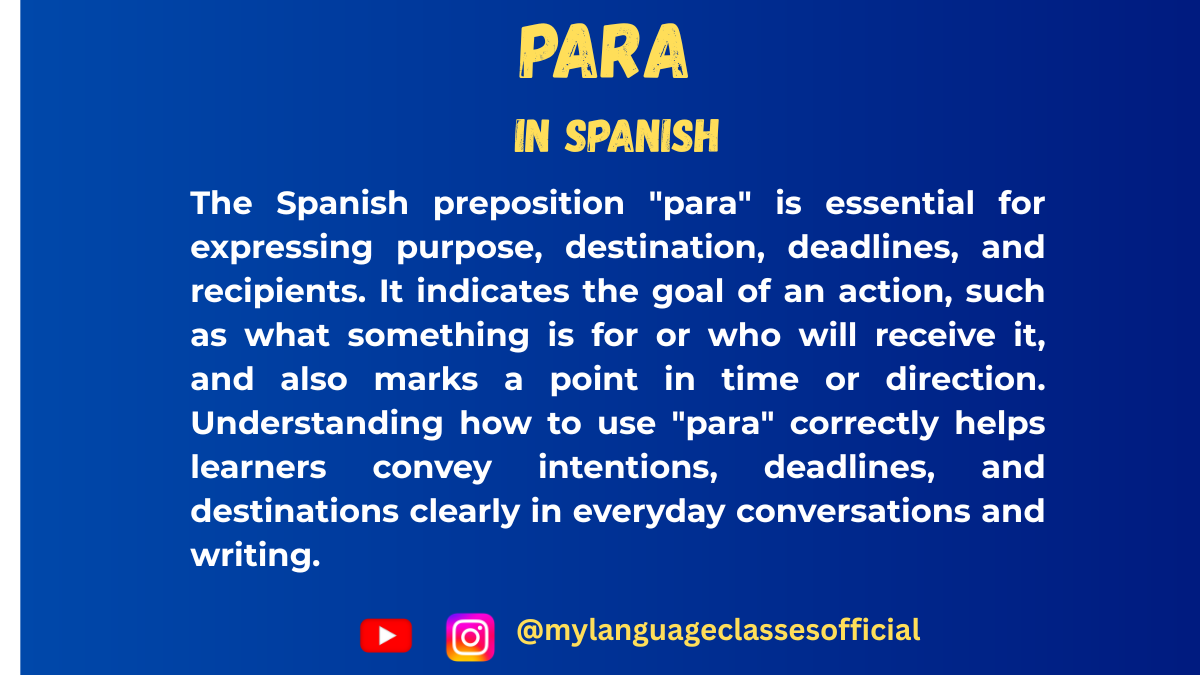
Everything You Need to Know About PARA in Spanish
When learning Spanish, one of the trickiest aspects is understanding the difference between “por” and “para.” While both can translate to “for” in English, they serve different purposes in Spanish. This article will focus on “para”—its uses, common expressions, and grammatical rules.
Uses of PARA in Spanish
“Para” is generally used to indicate purpose, destination, deadlines, recipients, and opinions. Below is a detailed explanation of its main uses:
Usage Explanation Example Sentence Purpose (In order to) Used to indicate the reason for doing something. Often translates to “in order to” in English. Estudio español para hablar con fluidez. (I study Spanish in order to speak fluently.) Recipient (For someone) Used when something is intended for a person or entity. Este regalo es para ti. (This gift is for you.) Destination (Towards a place) Indicates movement towards a destination. Salimos para Madrid mañana. (We are leaving for Madrid tomorrow.) Deadline (By, For a time limit) Used to indicate a deadline for an action. La tarea es para mañana. (The homework is for tomorrow.) Employment (To work for someone) Indicates employment or who you work for. Trabajo para una empresa grande. (I work for a big company.) Comparison (Considering that) Used when making a comparison or contrast. Para un niño de 5 años, él es muy alto. (For a five-year-old, he is very tall.) Opinion (According to someone) Used to express personal opinions. Para mí, este restaurante es el mejor. (For me, this restaurant is the best.) Use (For a specific use) Used when indicating the purpose of an object. Necesito un cepillo para el pelo. (I need a brush for my hair.)
Common Expressions with PARA
Below is a list of commonly used phrases and idioms with para in daily Spanish:
Expression Meaning Example Sentence Estar para + infinitive To be about to do something Estoy para salir. (I am about to leave.) Para siempre Forever Te amaré para siempre. (I will love you forever.) Para nada Not at all No me gusta el café para nada. (I don’t like coffee at all.) Para variar Just for a change Hoy vamos a la playa para variar. (Today we are going to the beach just for a change.) No es para tanto It’s not a big deal No llores, no es para tanto. (Don’t cry, it’s not a big deal.) Para colmo To top it all off Perdimos el tren y, para colmo, empezó a llover. (We missed the train, and to top it all off, it started raining.) Para que (+ subjunctive) So that Estudia mucho para que pases el examen. (Study hard so that you pass the exam.) Ser tal para cual To be two of a kind Juan y Ana son tal para cual. (Juan and Ana are two of a kind.)
Important Grammar Rules When Using PARA
1. Articles with PARA
- When using para before a noun, it may require a definite or indefinite article (el, la, los, las, un, una, unos, unas).
- Example: Este libro es para el profesor. (This book is for the teacher.)
2. Singular vs. Plural Forms
- “Para” itself does not change with gender or number, but the words following it do.
- Example: Las flores son para las madres. (The flowers are for the mothers.)
3. Using PARA with Pronouns
- Personal pronouns with “para”: para mí, para ti, para él/ella, para nosotros, para ellos.
- Example: Este mensaje es para ti. (This message is for you.)
4. PARA vs. POR
Since “por” and “para” both mean “for” in English, beginners often confuse them. Here’s a simple trick:
- Use PARA when there’s a destination or purpose. (Voy para Madrid.)
- Use POR when there’s a cause or reason. (Voy por el trabajo.)
Things to Keep in Mind When Using PARA
- If you are expressing a purpose (“in order to”), always use the infinitive verb form after “para.”
✅ Vine para aprender español. (I came to learn Spanish.)
❌ Vine para aprendo español. (Incorrect) - “Para” is not used when talking about duration—use “por” instead.
✅ Estudié por dos horas. (I studied for two hours.)
❌ Estudié para dos horas. (Incorrect) - In spoken Spanish, native speakers often use “para” with shortened forms like “pa’” in informal speech.
Example: Voy pa’ la casa. (I’m going home.) (Casual speech)
Final Thoughts
Understanding para is crucial for mastering Spanish. By learning its different uses and practicing with common expressions, you’ll improve both comprehension and fluency. Try to use para in your daily conversations, and pay attention to how native speakers use it!
If you enjoyed this lesson, be sure to check out more posts like this on my blog at My Language Classes. Don’t forget to subscribe my YouTube channel and follow me on Instagram for the latest language learning tips and lessons. Leave a comment below to share your thoughts, or ask any questions you have.
Happy learning! 😊
-
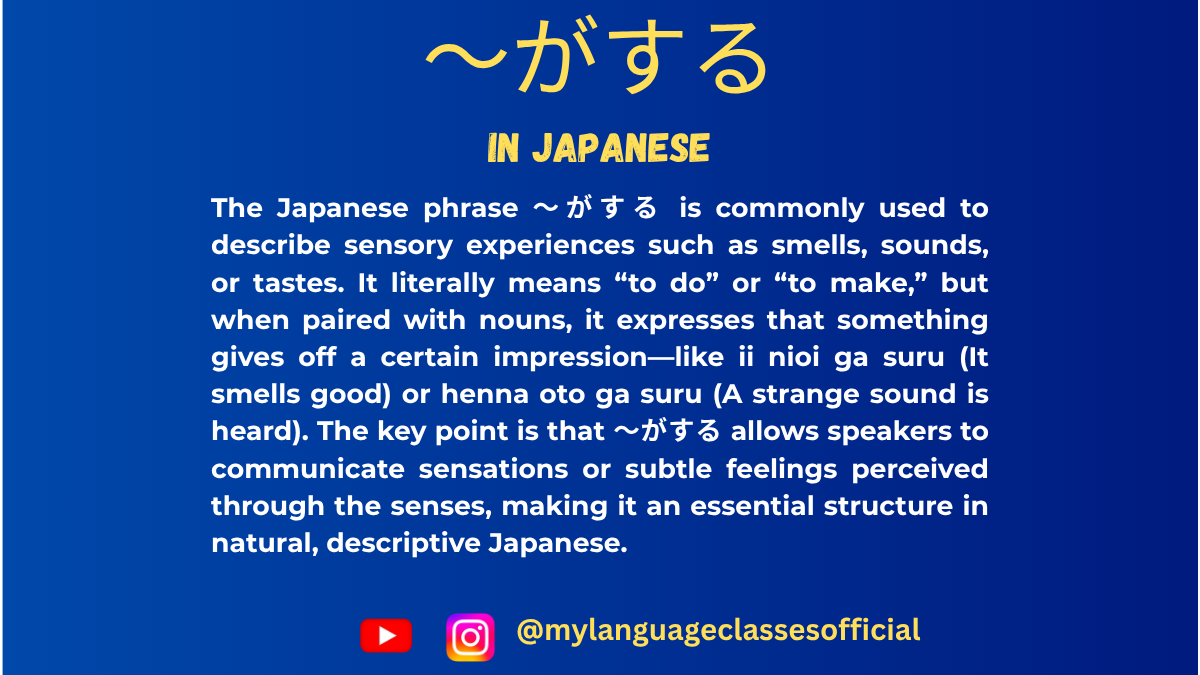
Understanding 〜がする in Japanese | My Language Classes
Understanding the Usage of 〜がする in Japanese
The expression 〜がする is a common grammatical structure in Japanese used to describe perceptions and sensations related to the five senses, as well as intuitive feelings. It is often translated as “to smell,” “to taste,” “to feel,” or “to sound like.” This phrase allows the speaker to express their sensory or emotional experience in a natural way.
Basic Structure of 〜がする
The pattern generally follows this structure:
[Noun] + がする
Here, [Noun] represents something perceived through the senses (such as smell, taste, sound, or feeling). The verb する indicates that the sensation exists.
Situations Where 〜がする is Used
Below are the different contexts where 〜がする is commonly used:
1. Smell (Odor-related Perception)
Used when describing a smell that one perceives.
- 変なにおいがする。 (Henna nioi ga suru.) – “There is a strange smell.”
- 花の香りがする。 (Hana no kaori ga suru.) – “I smell the fragrance of flowers.”
- ガスのにおいがする。 (Gasu no nioi ga suru.) – “It smells like gas.”
2. Taste (Flavor-related Perception)
Used when describing the taste of something.
- 変な味がする。 (Henna aji ga suru.) – “It has a strange taste.”
- この水は鉄の味がする。 (Kono mizu wa tetsu no aji ga suru.) – “This water tastes like iron.”
- 甘い味がする。 (Amai aji ga suru.) – “It tastes sweet.”
3. Sound (Auditory Perception)
Used when describing a sound that one hears.
- ドアの開く音がする。 (Doa no hiraku oto ga suru.) – “I hear the sound of a door opening.”
- 雷の音がする。 (Kaminari no oto ga suru.) – “I hear the sound of thunder.”
- 人の話し声がする。 (Hito no hanashigoe ga suru.) – “I hear people’s voices.”
4. Feeling (Emotional or Intuitive Perception)
Used when describing a feeling, intuition, or an atmosphere.
- 嫌な感じがする。 (Iyana kanji ga suru.) – “I have a bad feeling.”
- 胸騒ぎがする。 (Munasawagi ga suru.) – “I have a premonition (of something bad).”
- ワクワクする感じがする。 (Wakuwaku suru kanji ga suru.) – “I have an exciting feeling.”
5. Physical Sensations (Pain or Bodily Feelings)
Used when describing physical sensations or discomfort.
- 頭が痛い感じがする。 (Atama ga itai kanji ga suru.) – “I feel like I have a headache.”
- 吐き気がする。 (Hakike ga suru.) – “I feel nauseous.”
- 寒気がする。 (Samuke ga suru.) – “I feel chills.”
6. Other Abstract Feelings and Situations
It can be used to describe abstract or indirect experiences.
- あの人は信用できない気がする。 (Ano hito wa shinyou dekinai ki ga suru.) – “I feel like that person is untrustworthy.”
- ここは何か違う感じがする。 (Koko wa nanika chigau kanji ga suru.) – “This place feels different.”
Key Points to Remember
- 〜がする is used to describe sensory experiences, including smell, taste, sound, and physical or emotional feelings.
- It is typically used with nouns related to perception, such as におい (smell), 味 (taste), 音 (sound), 気 (feeling), 感じ (sensation), 痛み (pain), etc.
- It can be used for both literal (real sensory perceptions) and abstract (intuition, atmosphere, emotions) experiences.
- The phrase makes statements subjective, meaning it expresses the speaker’s personal perception rather than an objective fact.
Conclusion
Understanding 〜がする is essential for expressing sensory perceptions naturally in Japanese. Whether you’re describing a delicious meal, a strange smell, an ominous feeling, or an unexpected noise, this structure is an invaluable tool in communication. Mastering its usage will enhance your ability to express experiences vividly and naturally in Japanese.
By practicing various sentence patterns using 〜がする, learners can deepen their understanding and fluency in Japanese conversation. Try using it in your daily observations to get more comfortable with its application!
If you enjoyed this lesson, be sure to check out more posts like this on my blog at My Language Classes. Don’t forget to subscribe my YouTube channel and follow me on Instagram for the latest language learning tips and lessons. Leave a comment below to share your thoughts, or ask any questions you have about nouns.
Happy learning! 😊

